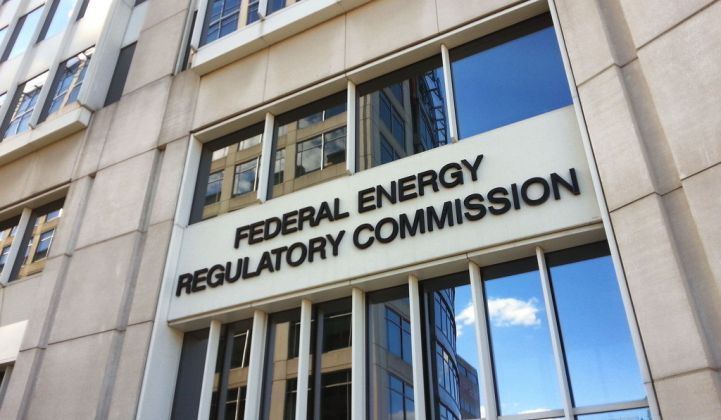After more than a year of delay, the two-Republican majority at the Federal Energy Regulatory Commission has told mid-Atlantic grid operator PJM how it must revamp its $10-billion-per-year capacity market. And at first glance, it could be even more harmful to state-subsidized renewable energy than previously imagined.
Thursday’s order would force almost all future state-subsidized resources in PJM's 11-state territory to use a “minimum offer price rule,” or MOPR, that would limit how low they can bid. Because almost all state subsidies and incentives are for zero-marginal-cost clean energy, this would create an artificial floor that masks their true cost-effectiveness — and essentially forces them out of the market — compared to existing coal, nuclear and gas-fired generation, critics say.
And unlike FERC’s June 2018 order that found PJM's capacity market in need of reform, Thursday’s order has removed some of the few openings for state-subsidized resources to continue to earn money for their capacity value, according to Commissioner Richard Glick, the sole Democrat at FERC.
For example, last year’s order proposed a resource-specific fixed resource requirement, which could allow generators and utilities to match their own capacity needs outside of PJM’s purview. "This particular order today eliminates that completely,” Glick said.
In a scathing dissent during Thursday’s meeting, Glick accused Republican FERC Chairman Neil Chatterjee and Commissioner Bernard McNamee of “nullifying state policies” with the order. “What we’re doing here — and we’re doing it on purpose — is making it very difficult for state-preferred resources to clear in the capacity market,” he said.
What’s more, the new order’s expanded definition of “state subsidy” could force a MOPR onto a broad class of resources yet to be built, he said. That includes all new generators built by municipal and cooperative utilities, which “blows up the business model” for these public power entities, and potentially all generators in states participating in the Regional Greenhouse Gas Initiative, he said.
Chatterjee, formerly a senior aide to Senate Majority Leader Mitch McConnell, defended Thursday’s order as an attempt to “level the playing field” for all resources amid a rising tide of state incentives for clean energy that are “suppressing prices in capacity markets.”
It’s not clear that this is the case, however. PJM has ample capacity and reserve margins, and while its most recent capacity auction yielded lower prices than those seen the year before, it has also been highly volatile from year to year since it was created in 2007. Wind and solar made up only 2 gigawatts of the more than 163 gigawatts of capacity procured in its last auction, giving it little pricing power compared to the natural-gas-fired power plants that made up the vast majority of capacity.
Glick countered Chatterjee’s argument for the new order as a fix to a broken market, noting that it introduces an unprecedented level of administrative interference into price formation. “What are we telling the states? What are we telling market participants? That we’re going to have some administrator in Valley Forge, Pennsylvania [the site of PJM’s headquarters] telling everyone what price they’re bidding?”
Chatterjee also noted that the new order contains exemptions for existing state-backed resources, as well as future “unit-specific exemptions,” allowing individual generators to place a bid based on their individual costs. But Glick conditioned this characterization of the order, which had not yet been published Thursday morning, noting that it establishes “two different MOPR prices," with "a different pricing mechanism for existing generation and new generation.”
Glick added that PJM has only about 5,000 megawatts of renewables installed to date that will receive this exemption, but that the roughly 38,000 megawatts of new renewable generation in the pipeline will be subjected to the MOPR and thus almost certainly barred from participating in PJM’s capacity market.
The new order could also force a MOPR on state-subsidized nuclear power plants in Illinois and New Jersey, or the nuclear and coal plants that won subsidies from Ohio lawmakers this year. “But that misses the point,” Glick said. “The vast majority of PJM states are moving forward with clean energy programs,” while nobody is building new coal plants.
The costs of barring these new state-subsidized resources could add up to billions of dollars in higher rates for customers in PJM territory, with various projections ranging from $1.6 billion to $5.7 billion a year. Glick cited a cost estimate of about $2.4 billion per year, with costs rising in future years as more and more state-subsidized energy is built, yet barred from providing its low-cost capacity from PJM’s market for valuing that vital need.
Glick also predicted that the order would face legal challenges that would prevent PJM from complying within the 90 days it demands. This will likely further delay an auction that PJM has already been forced to cancel for this year, with unclear but potentially significant impact on the natural-gas-fired generators, and to a lesser extent the renewable and demand-side resources, which rely on the market for a portion of their revenues.
Initial reactions from opponents of PJM’s decision indicate a fight ahead. Jeff Dennis, general counsel and managing director at Advanced Energy Economy, called Thursday’s decision an “unfortunate and unnecessary transformation of a limited rule designed to prevent market manipulation into a price support scheme for existing coal and natural gas power plants.”
Amy Farrell, senior vice president of government affairs for the American Wind Energy Association, said it “threatens states’ rights and hinders their ability to bring more clean energy to their communities.” And Mike Jacobs, senior energy analyst at the Union of Concerned Scientists, said that “FERC is not indifferent to state policies that address carbon emissions — they are actively attacking them.”




